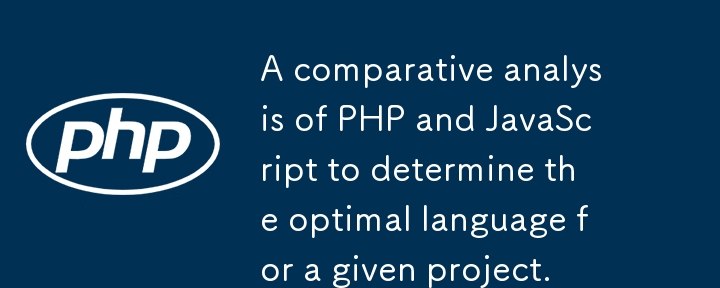

When selecting the appropriate language for a forthcoming project, it is essential to understand the relative strengths, limitations, and optimal applications of both PHP and JavaScript. While both are highly capable tools in the field of web development, they are best utilized for distinct purposes and are better suited to different types of projects.
PHP is primarily used for server-side scripting. It is particularly adept at performing backend operations, including database interactions, file processing, and the g
PHP boasts a large community and a long history in web development. It has a vast community, extensive documentation, and a wide range of frameworks like Laravel, Symfony, and CodeIgniter, which streamline the development process and mitigate the complexity introduced by the vanilla PHP.
Additionally, PHP is widely supported by web hosting providers and often comes with built-in support for popular content management systems like WordPress, Joomla, and Drupal.
One disadvantage of PHP is that it can only be used on a server, not in a browser. This means that JavaScript or another front-end technology is required for dynamic content on the client side.
Another limitation of PHP is that it handles each request separately, which is less efficient for real-time applications than languages designed with concurrency in mind, like Node.js.
Photo by Lautaro Andreani on Unsplash
JavaScript is a versatile, cross-platform front-end and back-end language with a wide range of strengths. The Versatile Frontend and Backend Language
The advent of Node.js has enabled JavaScript to be used for both frontend and backend development, making it an ideal choice for full-stack projects.
The ability to interact with clients in a dynamic manner is a key strength of JavaScript.
JavaScript is the language of the web, facilitating client-side interactivity. It is the foundation for a wide range of applications, from simple animations to complex single-page applications (SPAs), with frameworks such as React, Angular, and Vue.js.
Non-blocking, event-driven nature, and asynchronous behavior allow Javascript to complete tasks in a non-blocking manner, which is ideal for handling real-time data, such as in chat applications, live updates, and streaming services.
The JavaScript ecosystem is vast, comprising numerous libraries, frameworks, and tools that empower developers to create a diverse array of applications.
After citing all the powerful features that Javascript offers, let’s focus in the next lines on its limitations in different aspects.
Browser Dependence:
The performance and the behaviour of JavaScript code can vary depending on the browser in use. Despite the fact that contemporary browsers have largely standardized JavaScript implementation, there are nevertheless some differences, particularly in the case of older browsers.
Client-Side Execution:
As JavaScript is executed on the client side (in the user’s browser), it is susceptible to certain security risks, such as cross-site scripting (XSS) attacks, where malicious code is injected into web pages.
Restricted Access to System Resources
The execution of JavaScript in a browser environment is constrained by the limitations of a sandbox, which restricts its access to system resources. This is a security feature; however, it also precludes JavaScript from performing certain tasks, such as interacting directly with the file system or running other programs.
Asynchronous Complexity
Asynchronous operations in JavaScript, such as API calls or file reading, can result in the creation of deeply nested callbacks, a phenomenon known as “callback hell.” This can render the code difficult to read and maintain.
To mitigate this complexity and unwanted behavior,
JavaScript provides solutions like Promises and async/await to handle asynchronous code in a more elegant manner, these still necessitate a comprehensive understanding to circumvent potential pitfalls, such as unhandled promise rejections or race conditions.
強い型付けが不十分です
JavaScript は動的に型指定される言語です。つまり、変数は実行時に型を変更できます。これにより柔軟性が得られますが、特に大規模で複雑なコードベースのコンテキストでは、特定が困難なバグが発生する可能性もあります。
タイプ セーフティの概念は、コンピューター サイエンスの分野の基礎です。型安全性がない場合、不適切な引数の型を関数に渡すなどのエラーが比較的簡単に発生し、実行時まで識別できない可能性があります。
シングルスレッドの性質
JavaScript はシングルスレッドです。つまり、一度に 1 つのタスクを実行します。これにより多くのプログラミング タスクが簡素化されますが、真の並列処理を必要とするアプリケーションには制限が生じる可能性があります。
パフォーマンスに関する懸念事項JavaScript は、大量の計算を必要とするタスクにはあまり適していません。期間。これには、複雑な数学的計算とデータ処理が含まれます。 Web ワーカーはタスクをバックグラウンド スレッドにオフロードするのに役立ちますが、JavaScript は一般に、C++ や Rust などの言語と比較して CPU 集中型の操作の効率が低くなります。
結論
The above is the detailed content of A comparative analysis of PHP and JavaScript to determine the optimal language for a given project.. For more information, please follow other related articles on the PHP Chinese website!




